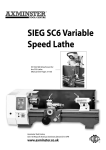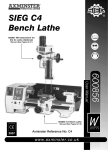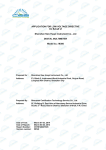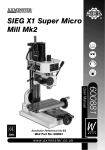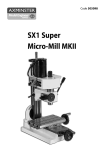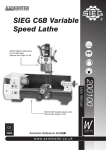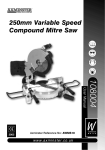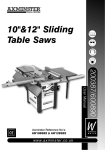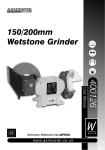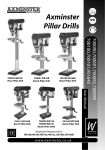Download Axminster ZX25M User manual
Transcript
ZX25M & ZX30M Vertical Mill & Drill ZX30M User Manual 990123,700093 ZX25M W 2002 Axminster Reference No:ZX25M & ZX30M w w w. a x m i n s t e r. c o . u k AXMINSTER W H I T E Index of Contents... Page No. Index of Contents.............................................................................................................................................. 2 Declaration of Conformity………….………........……..…………...................................................................2 What’s in the Box………….………........……..………….................................................................................... 3 General Instructions for 230v Machines......................................................................................... 4 Initial Assembly and Testing........................................................................................................... 5 Initial Check List............................................................................................................................6,7 Specification..….………........……..…………...................................................................................................7 Definitions.………........……..…………...............................................................................................................8 Parts Identification and Description................................................................................................ 8 Machine Illustration of the Mill/Drill................................................................................................ 9 Parts Identification and Description (Continued).................................................................... 10,11 Machine Illustration of the Mill/Drill (Continued).....................................................................12,13 Parts Identification and Description (Continued)......................................................................... 14 Machine Illustration of the Mill/Drill (Continued).......................................................................... 15 Parts Identification and Description (Continued)......................................................................... 16 Machine Illustration of the Mill/Drill (Continued)..........................................................................17 General Operating Instructions................................................................................................ 18,19 Maintenance..............................................................................................................................20,21 Mill/Drill Oiling Points............................................................................................................... 22,23 Speed Select Table........................................................................................................................ 23 Parts Breakdown.......................................................................................................................24-25 Parts LIst....................................................................................................................................26-27 The undersigned, D.C. Rexwinkel authorised by Shaoxing Yuejian Machinery Manufacture Co., Ltd Jiahui Zhonglou, Shaoxing P.R. China declares that this product: ZX-25M & ZX-30M Copied from CE Certificate (Milling/Drilling Machines) manufactured by Shaoxing Yuejian Machinery Manufacture Co. is in compliance with the following standards or standardisation documents in accordance with Council Directives EN 12717:2001, EN 13128:2001, EN 60204-1:1997 98/37/EC, 73/23/EEC Saf y Helm fet sp irator Re Sa Two E R Ey fety Viso Sa AXMINSTER W H I T E Safety Protection Symbols et st Mask Du F ootw ety r Def ende rs n ar s ve ro tectio eP tiv e Glo tec r ea n Asse Ma bly m al W d Manu ea Pro ! The symbols shown on the cover of this manual advise that you wear the correct safety protection when using this machine. SAFETY!! What’s in the Box... W AXMINSTER W H I T E Model Numbers: 1 No. ZX-25M & ZX-30M Vertical Mill/Drill Box 1 No. Drill Chuck with Chuck Key 1 No. No. 3 MT /R8 Mounting arbor for Drill Chuck 3 No. 125mm Wheel handles 1 No. 100mm Wheel Handle 4 No. (3+1)Rod Handles (detached for packing) 1 No. Double Open Ended Spanner 17mm A/F x 19mm A/F 1 No. Allen Key 4mm 1 No. Allen Key 5mm 1 No. Allen Key 6mm 1 No. Allen Key 8mm 1 No. Break Taper Drift 1 No. Main Tool Post Cap 1 No. Drive Belt Cover Infill Cover 1 No. Draw Bar Nut Cover 2 No. Draw Bars (Stowed in Drive Belt Compartment) 1No. x M10, 1No. x 3/8" Whitworth (NOT ZX30M M10 ONLY) 1 No. Guarantee Card 1 No. Instruction Manual ! WARNING. The ZX 25 Mill is a heavy piece of equipment. You are advised to seek help or the use of some form of lifting device, (hoist, engine crane etc., ) before you attempt to lift or move this machine. Having unpacked your machine and its accessories, please check the contents against the equipment list ”What’s in the box”, if there are any discrepancies, please contact Axminster Power Tool Centre using the procedures laid down in the catalogue. Please dispose of the packaging responsibly, much of the material is bio-degradable. The machine and its accessories will arrive coated with heavy corrosion preventative grease. This will need to be cleaned from the machine, its components and accessories prior to it being set up and commissioned. Use coal oil, paraffin or a proprietary degreaser to remove the barrier grease. Be warned, it will stain if you splash it on clothing etc., wear overalls, coverall et al., rubber gloves are also a good idea, as is eye protection if your cleaning process tends to be a little bit enthusiastic. After cleaning, lightly coat the exposed metal surfaces of the machine with a thin layer of light machine oil. N.B If you used paraffin/kerosene make sure you apply this thin film sooner rather than later. ! Please read the Instruction Manual prior to using your new machine; as well as the installation procedure, there are daily and periodic maintenance recommendations to help you keep your machine on top line and prolong its life. Keep this Instruction Manual readily accessible for any others who may also be required to use the machine. 03 W AXMINSTER W H I T E General Instructions for 240V Machines... Good Working Practices/Safety The following suggestions will enable you to observe good working practices, keep yourself and fellow workers safe and maintain your tools and equipment in good working order. ! WARNING!! KEEP TOOLS AND EQUIPMENT OUT OF THE REACH OF YOUNG CHILDREN Mains Powered Tools Primary Precautions These machines are supplied with a moulded 13 Amp. Plug and 3 core power cable. Before using the machine inspect the cable and the plug to make sure that neither are damaged. If any damage is visible have the machine inspected/repaired by a suitably qualified person. If it is necessary to replace the plug, it is preferable to use an ‘unbreakable’ type that will resist damage. Only use a 13 Amp plug, make sure the cable clamp is tightened securely. Fuse at 13 Amp. If extension leads are to be used, carry out the same safety checks on them, and ensure that they are correctly rated to safely supply the current that is required for your machine. Work Place/Environment The machine is not for working outside,do not use when or where it is liable to get wet. If tool does get wet; dry it off as soon as possible, with a cloth or paper towel. Do not use 230Va.c. powered machines anywhere within a site area that is flooded or puddled, and do not trail extension cables across wet areas. Keep the machines clean; it will enable you to more easily see any damage that may have occurred. Clean the tool with a damp soapy cloth if needs be, do not use any solvents or cleaners, as these may cause damage to any plastic parts or to the electrical components. Keep the work area as well lit and uncluttered as is practical, this includes personnel as well as material. Under no circumstances should CHILDREN be allowed in work areas) ! 04 It is good practice to leave the machine unplugged until work is about to commence, also make sure to unplug the machine when it is not in use, or unattended. Always disconnect by pulling on the plug body and not the cable. Once you are ready to commence work, remove any tools used in the setting operations (if any) and place safely out of the way. Re-connect the machine. Carry out a final check e.g. check the cutting tool, drill bit etc., is securely tightened in the machine, check you have the correct speed and function set, check that the power cable will not ‘snag’ etc. For milling operations ensure the workpiece is secured to the machine bed, and that the machine bed is clear of all setting tools, spanners, clamps etc., check the proposed machining path of the tool does not lie through any clamp or hold down components. Make sure you are comfortable before you start work, balanced, not reaching etc., If the work you are carrying out is liable to generate flying grit, dust or chips, wear the appropriate safety clothing, goggles, gloves, masks etc., If the work operation appears to be excessively noisy, wear ear-defenders. If you wear your hair in a long style, wearing a cap, safety helmet, hairnet, even a sweatband, will minimise the possibility of your hair being caught up in the rotating parts of the machine, likewise, consideration should be given to the removal of rings and wristwatches, if these are liable to be a ‘snag’ hazard. Consideration should also be given to non-slip footwear, etc. Do not work with cutting or boring tools of any description if you are tired, your attention is wandering or you are being subjected to distraction. A deep cut, a lost fingertip or worse; is not worth it! Do not use this machine within the designated safety areas of flammable liquid stores or in areas where there may be volatile gases. There are very expensive, very specialised machines for working in these areas, THIS IS NOT ONE OF THEM. Check that cutters, drills etc., are the correct type and size, are undamaged and are kept clean and sharp, this will maintain their operating performance and lessen the loading on the machine. Above all, OBSERVE…. make sure you know what is happening around you, and USE YOUR COMMON SENSE. Initial Assembly & Testing... Ideally, your mill should be installed close to a correctly rated power supply, in a warm dry environment, well ventilated and illuminated by bright clear natural light, with adequate access all around the machine, and sufficient adjacent storage space for your tools, accessories and material. W AXMINSTER W H I T E The ZX25M & ZX30M Mill’s are best mounted on a rigid bed, this is to ensure stability of the machine and to attenuate any vibration that is generated when the machine is running, (especially with eccentric tooling mounted). The bed should be flat and set level in both planes, and at a height that enables comfortable operation of the machine. It is not necessary to anchor the bed through to the floor, but it must be stable enough to remain immovable during any normal forceful operations (especially tightening) carried out whilst operating your machine. If you are preparing your own bed for the machine, it should be at least 600mm deep by 430mm wide; (to cover the footprint of the base of the mill), you will need to drill four 12.5mm holes to allow for bolt fixing. Set out the centres of the holes in a square matrix; 325mm x 462mm, and secure the machine with adequate length M12 bolts, nuts, and washers. (Please read the section entitled Identification and Parts description so that you may more easily identify the parts to which reference is made in the text). Locate and identify the 3 No.125mm wheel handles from the packing box. Fit these to the ends of the work table shaft, and the traverse feed shaft, engage the dogs and tighten the holding grubscrews through to the flats machined on the shafts. Add the three larger rod handles to these wheel handles by screwing the pivot post into the handle and lock on with the supplied nut. Locate and identify the 100mm wheel handle, fit to the shaft of the fine feed mechanism, engage the dogs and likewise secure with the grubscrew etc. fit the smaller rod handle to the wheel handle. Locate the head raise and lower mechanism. The winding handle has been fitted (loosely) reversed. (ZX30M handle in tool box), Remove the handle, turn it to the correct orientation and refit to the shaft, once again ensure that the securing grubscrew is driven against the flat machined into the shaft. DO NOT attempt to raise or lower the head at this stage. Loosen the small Bristol handle that locks the motor mounting yoke in position (to allow the belts to be tensioned). (ZX30M, ONLY) draw bar supplied is M10. Raise headstock to enable cover to be opened. Undo the two clips that secure the top drive belt cover, raise the cover. Remove the two draw bars that were packed there. (NOT ZX30M) The intermediate jockey pulley tower is held in position by two securing bolts through the mounting bracket of the swing arm. Loosen these bolts to allow the arm to move and fit the belts, (refer to the chart on the side of the drive belt cover for the required speed). Physically ‘jiggle and wiggle’ and push and pull to get the motor moved and the belts tensioned, relock the motor yoke lock. Re-tighten the securing bolts of the swing arm. Lower the drive belt top cover and re-clip. Locate the infill cover and clip into the void in the top cover. Locate the draw bar nut cover and clip into the top drive belt cover. Locate the Main Tool Post Cap, place over the top of the main tool post and nip in position with the grubscrew. You should now be ready to proceed with the initial check list. 05 W Initial Check List... AXMINSTER W H I T E When the mill is mounted to your satisfaction, proceed as follows:a) Locate the Head Clamp Bolt Nuts, loosen these. b) Ensure that the bevel cup that houses the end of the head raise and lower rack is clear and unblocked, ensure that there are no impediments to the head assembly or the tool, and swing the head through a full 360˚. Position the head approximately over the centre line of the work table. Raise and lower the head using the winding handle. Set the head to the required height and reposition if necessary. Tighten the head clamp bolt nuts. c) Check that the positive depth stop nuts are at both extremes of the gauge bar. (i.e. full unrestricted movement). d) Check the quill clamp is loose. e) Check the fine feed clutch mechanism is disengaged, (the star knob is unscrewed anticlockwise, toward the front of the mill). Check the ‘coarse’ feed mechanism of the quill using the tri-handle, check that feed and movement is smooth, and the return spring counterbalance is effective. f) Engage the fine feed mechanism, (the star knob is screwed in clockwise), check the tri-handle is virtually immoveable (against the gear mechanism of the fine feed), raise and lower the quill using the fine feed control wheel handle. Check at the same time that the ‘thimble’ measuring scale can be set to position and when tightened, rotates freely and remains synchronized with the fine feed control handle (Note. The mechanism is quite ‘stiff’ when the machine is new, and will ease, although the feed will always be harder against the counter balance spring than when aided by the spring on the return). Disengage the fine feed mechanism. NOTE: Measuring Scale fixed on ZX30M g) Position the quill to an arbitrary position at about mid travel and tighten the quill clamp lever. Check that the quill does not move. Release the quill clamp. h) Set the positive depth stop nuts to ‘some’ position and check that they do restrict the movement of the quill. Reset them to ‘0-0’. Scale for Depth Control on the ZX30M is positioned on the front panel of the headstock. (See fig 3) i) Ensure the longitudinal feed locks are undone. Using the drive handles wind the work table side to side along the ‘X’ axis. Check you have full movement, driving the work table into the centre stop from each side. Check at the same time that the ‘thimble’ measuring scale can be set to position and when tightened, rotates freely and remains synchronized with the drive handle. Position the work table approximately mid-way, tighten the table locks and check that the table will not move when a ‘reasonable’ force is applied to the drive handles. (Note. The term ‘reasonable’ force is used to indicate a force you would normally use to proceed with this action, the ‘stopped/braked/locked’ re-action to this force is to make you consider why the object has not moved, and investigate. It is not to make you bunch muscles and ‘heave’). Undo the locks. 06 j) Ensure the traverse clamps are undone. Using the drive handle, drive the work table back and forth along the ‘y’ axis. Check you have full and unrestricted travel. Check at the same time that the ‘thimble’ measuring scale can be set to position and when tightened, rotates freely and remains synchronized with the control handle. Position the work table approximately mid- way. Tighten the traverse feed locks, and check that the traverse feed will not move when a ‘reasonable’ force is applied to the drive handle. Undo the traverse clamps. Initial Check List (Continued)... k) Swing the guard into position in front of the tool. The rising cam should have raised the roller plunger of the interlock microswitch. If this is not the case, reposition the rising cam so that this is so. (See fig 8) W AXMINSTER W H I T E l) Check that all loose tooling etc., has been removed from the work table. Check the tool is firmly mounted in the quill, the chuck, et al, or remove all tooling, chuck etc. completely. m) Raise the drive belt top cover. Plug the cable into the connecting socket and into the mains supply. Check that there is nothing to foul the tool if the machine were to be started. ‘Unclip’ the safety cover of the switch. Press the start button, check the machine does not start. Lower the drive belt cover and clip shut. Give the machine a ‘quick burst’ (Pressing the start and stop buttons) Check the machine started and stopped as required, check nothing untoward occurred, e.g. bad vibration, belt slippage, etc. If you are satisfied, start the machine, allow it to run for a few seconds, then swing the guard out of position. Check the machine stops. Reposition the guard and start the machine again. ‘Slap’ the switch cover closed, (acts as an emergency stop), check the machine stops. (a moulded portion of the switch cover depresses the stop button). If all the above checks where satisfactory, your mill is ready for use. Enjoy. Specification... Axminster No. 990123 ZX25M ZX30M Rating: Trade Trade Power Supply: 240v a.c. 50Hz 240v a.c. 50Hz Motor: 750W 1.5kW Maximum Drilling Capacity: 25mm 32mm Maximum Swing: 404mm 405mm Maximum Distance Spindle Nose to Table: 380mm 475mm Spindle Speeds: 90-2150rpm 100-2080rpm Spindle Taper: MT-3 MT-3 Diameter of Spindle Sleeve: 62mm 75mm Max Spindle Travel: 100mm 130mm Angle of Head Swivel: 360˚ 360˚ Column Diameter: 92mm 115mm Table Size: 585 x190mm 730 x 210mm Longitudinal Table Travel: 370mm 175mm Transverse Table Travel: 160mm 500mm Weight: 220kg 270kg Footprint L X W X H: 1320 X 900 X 960mm 1095 X 1010 X 1125mm 12 No. 700093 07 W AXMINSTER W H I T E Definitions... X’ Axis. This is the axis described by the work table as it moved side to side. Normally, movement that moves the tool to the right in the workpiece is referred to as +ve ‘X’, and movement that moves the tool to the left in the workpiece is referred to as –ve ‘X’. Where the initial position of the tooling and the worktable is designated 0,0. (Horizontal plane only). ‘Y’ Axis. This is the axis described by the work table as it is moved from front to back. (Traverse) Normally movement that moves the tool to the front in the workpiece is referred to as-ve ‘Y’, and movement that moves the tool to the rear in the work piece is referred to as+ve ‘Y’. Where the initial position of the tooling and the worktable is designated 0,0. (Horizontal plane only). ‘Z’ Axis This is the axis described by the worktable in the vertical plane. (Not possible with this machine). However, to establish a point in space, the co-ordinates can be transferred to the ‘tip’ of the tooling, whereby, if we assume that the tool and the worktable in their initial positions, where designated 0,0,0, (Horizontal and vertical planes) any point above the tool tip is referred to as +ve ‘Z’, and any point below the tool tip is referred to as -ve ‘Z’. Parts Identification and Description... Please take some time to identify the various parts of your machine so that you are familiar with the terminology we will use to enable you to set up and operate your Mill safely and correctly. Base casting (See Fig 1) This is the ‘Stand’ for the milling m/c . It has a square seating flange to the rear, which mounts the Main Tool Post Housing. There are 4 No.12mm holes in the approximate corners of the base to enable it to be bolted to a bench or the stand. There is also a dovetail slide machined on the front top surface of the base, to mount the traverse slide of the worktable. In the front face of the base is a machined housing which mounts and anchors the drive shaft for the traverse feed. Main tool post This is the column of the mill, it is a 92mm (115mm ZX30M) diameter steel (See Fig 1) tube onto which the milling head is mounted. The column is fitted with the rise and fall rack to enable the milling head to be raised and lowered. The rise and fall rack is held in place between a cup chamfer in the mounting housing and a cup chamfered retaining collar and cap that slides over the top of the pillar and is held in position by a locking screw. 08 Traverse slide The traverse slide mounts onto the dovetail slide of the base casting. There is (See Fig 1) a gybe strip fitted to the right side dovetail to maintain the fit. The underside of the slide has a threaded dog mounted in a fixed position, through which the traverse drive shaft is threaded so as to enable the slide to be driven back and forth. The top of the traverse slide has a female dovetail machined into it, perpendicular to the lower dovetail. This marries with the dovetail on the underside of the worktable. The rear face of the dovetail is fitted with a gybe strip to maintain the fit. The top of the slide also has a fixed threaded dog mounted to it, through which the drive shaft of the worktable is threaded to allow the worktable to be driven from side to side. The positive stop plate for the worktable is also bolted to the front of the traverse slide, and there is a threaded hole at each end of the front face into which a small Bristol handled bolt is fitted to enable the worktable to be locked in position. There are also two locks (small Bristol handles) on the right hand side which are tightened to lock the traverse slide into position. Machine Illustration of the Mill/Drill... Tool post top cover Draw bar nut cover W AXMINSTER W H I T E Fig 1 Motor Milling head casting Fine feed assembly Tri-lever feed handle Tool guard Facing cutter Main tool post Worktable Traverse slide control Worktable drive control Fig 1a Traverse slide Base casting Traverse feed locks FREEPHONE 0800 371822 09 W Parts Identification and Description (Continued)... AXMINSTER W H I T E Traverse slide control (See Fig 1) The traverse slide is driven using the 125mm wheel and rod handle at the front of the machine. Behind the boss of the handle is a graduated ring (thimble) so that the movement of the slide can be measured. The thimble is held to the drive shaft by friction, but can be pre-positioned and locked in place by a ribbed thumb screw to establish a predetermined start or stop dimension. Worktable (See Fig 2) The Worktable is a machined casting 585mm long by 190mm wide, (730x210mm for the ZX30M). There is a clearance ‘well’ at each end of the table and the centre span of 450mm, (560mm for the ZX30M) has 4 No. ‘T’ slots machined along its length, to facilitate the fixing of machine vices or clamps. The ‘T’ slots are 24mm. (See Fig 2). The worktable is mounted onto the traverse slide. The end faces of the worktable have housings machined in them to mount and anchor the drive shaft. The front face of the worktable has a slot machined into it, into which the positive stops are mounted. These stops can be moved and secured anywhere along the slot, and will strike against the positive stop plate to limit the travel of the worktable. Worktable The Worktable slide is driven using the 125mm wheel and rod handles at drive control either end of the table. Behind the boss of the right hand side handle is a (See Fig 1) graduated ring (thimble) so that the movement of the worktable can be measured. The thimble is held to the drive shaft by friction, but can be pre-positioned and locked in place by a ribbed thumb screw to establish a predetermined start or stop dimension. ‘T’ Slots Fig 2 Adjustable stops Longitudinal feed locks 10 Postive stop plate Drip cover Parts Identification and Description (Continued)... W AXMINSTER W H I T E Milling Head This is the ‘milling machine’ and the descriptions of its various parts and components are detailed as follows:Milling head casting (See Fig 1) The main casting to which all the components are attached. The head has a sleeve housing machined at the rear, which allows the casting to be fitted to the Main Tool Post. There are two M12 bolts, washers and nuts to the rear of the sleeve housing which clamp the casting to the main tool post. Motor (See Fig 3) Standard 240V 50Hz single phase motor rated at (750W 1 H.P. ZX25M) (1500W 2 H.P. ZX30M) Pulley and drive A pressed sheet steel compartment consisting of a lower tray and an upper belt cover cover, the cover is hinged on one side and secured by two toggle clips on the (See Fig 3) other. It covers the drive belt train for safety during normal operation. There is a microswitch fitted between the cover and the lower tray; which will prevent the machine running if the cover is not lowered. Pulleys and drive belts (See Fig 3a) There are three pulley towers in the millhead, the drive pulleys fixed to the motor shaft, the driven pulleys fitted to the quill, and the intermediate ‘jockey’ pulleys that connect the ‘train’ together with the two drive belts. A total of 12 speeds are available using the various belt positions on the pulleys. (See the chart on the machine or later in this manual. Head locking bolts (See Fig 3b) These are two M12 bolts, washers and nuts that clamp the sleeve housing at the rear of the head. They should be loosened to allow the head to raise and lower and pivot about the post. When the required position is achieved, re-tighten them to lock the head in position. The machine should not be operated with the head in the unlocked state. Motor mounting The motor is mounted on a pivoted plate, which forms part of the tensioning plate system for the drive belt train. The pivot plate is hinged on the left and the (See Fig 3b) positioning bar (yoke) is in turn hinged off the right side of the plate and is entered into a tunnel housing in the head casting. There is a small Bristol handled bolt that screws into the side of the tunnel housing and will clamp the yoke in position. It is good practise to release the tension in the drive belt train if the machine is not going to be used for any lengthy period. Tri-Lever feed handle Three levered handle that is used to drive the quill (and hence the chuck or the tool) up and down. The boss of the handle is fitted to the end of a ‘splined’ gear shaft. This ‘splined’ gear is, in turn, engaged in the rack cut into the quill body. The other end of the ‘splined’ shaft is engaged in a contra-wound spring, this provides counter balance to the weight of the quill, arbor, chuck and drill, giving a more controlled ‘feel’during drilling operations. It also retracts the quill when drilling is completed. Draw bar nut cover (See Fig 3) A moulded plastic cover that clips into the top of the drive belt cover, to afford protection from the rotating top of the draw bar, when the quill is at the top of its travel. Speed Select Table (See Fig 11) A small chart, which shows the pulley and belt configurations required to attain the various speeds available on the machine. 11 Machine Illustration of the Mill/Drill (Continued)... W AXMINSTER W H I T E Speed select table SPEED 90 170 200 250 280 360 SPEED BELT POSITION 4-5 4-6 3-5 2-5 4-7 3-6 600 700 950 1290 1590 2150 Pulley and drive belt cover BELT POSITION 1-6 2-7 1-7 3-8 2-8 1-8 Toggle clip Draw bolt nut cover Infill cover Scale & depth control Toggle clip Motor Star knob (find feed clutch) ZX30M ONLY Tri-lever feed handle Fine feed handle Fig 3 12 Machine Illustration of the Mill/Drill (Continued)... W AXMINSTER W H I T E Microswitch Toggle clips Fig 3a Idler pulley bracket lock Draw bars shown in original transport position (remove before use) (NOT ZX30M) Draw bar Pulleys and drive belts Yoke clamp handle Head locking bolts Motor mounting plate Fig 3b 13 W AXMINSTER W H I T E Parts Identification and Description (Continued)... Fine feed assembly (See Fig 7) The fine feed assembly floats around the splined gear shaft that drives the quill up and down. When the action of the fine feed mechanism is required; tightening the ‘engaging’ knob presses the tapered inside face of the boss of the tri-lever feed handle into a tapered receiver in the fine feed assembly. This locks them together. The internal end of the tapered receiver is part of a worm drive which is connected to the fine feed control handle on the front of the head. This now allows the quill to be driven down with greater precision. When the ‘engaging’ knob is unscrewed a spring loaded plunger in the back face of the boss breaks the taper lock, and separates the boss and the fine feed assembly. Behind the boss of the fine feed control wheel handle is a graduated ring (thimble) so that the movement of the quill can be measured. The thimble is held to the drive shaft by friction, but can be pre-positioned and locked in place by a ribbed thumb screw to establish a predetermined start or stop dimension. Positive depth stop (See Fig 6a) This is a threaded metal rod with a flat machined along it. The lower end of the rod is screwed into a shaped cast bracket that is fitted around the end of the quill sleeve; the rod is then fed through a lug cast on the lower edge of the main casting, a nut is threaded onto the rod on either side of the lug, which, when adjusted can provide a positive stop on both the ‘plunge’ and return stroke of the quill, if so required. A graduated scale is fastened to the machined flat of the rod to enable the ‘plunge’ depth to be read off. This assembly is mounted on the front of the headstock casting in the case of the ZX30M. Quill return spring cover (See Fig 6b) A chrome cover that covers the quill return spring Fig 6a Fig 6 14 Machine Illustration of the Mill/Drill (Continued)... W AXMINSTER W H I T E Fine feed thimble Fig 7 Fine feed handle Fig 6b Quill clamp Quill return spring cover 15 W AXMINSTER W H I T E Parts Identification and Description (Continued)... On/Off switch (See Fig 9a/b) A NVR switch panel mounted on the left front of the machine. Green ‘I’ will start the machine; red ‘O’ to stop. Should power be interrupted whilst the machine is in use, the NVR will ensure the machine has not remained in the switched on condition when power is restored. The top cover of the switch provides a security lock, in that when it is closed a small padlock can be snapped into place to prevent the machine being run. It also acts as a quick action ‘emergency off’ switch, in that an interior moulding inside the cover depresses the Off switch when it is closed. Being hinged on one side the cover can be ‘slapped’ shut to switch the machine off quickly. shaft onto which the bent crank handle is fitted. NOTE. The rise and fall mechanism should not be operated unless the head clamping bolts and nuts have been loosened off. Fig 8 Tool Guard (See Fig 9) A clear moulded plastic shield mounted on a swing arm. The pivot of the swing arm is a metal rod that is fitted through a lug located at the left rear of the milling head. On the top of the rod is a riser cam, that activates an interlock microswitch, so that the machine will not run unless the guard is in place. The position of the guard and the riser cam can be altered to allow the guard to be postioned around the tool anywhere within the work envelope of the machine. Quill clamp (See Fig 9) A bent chrome rod lever, inserted into a threaded hole that is machined in the side of the main bore housing the spindle sleeve. Screwing the lever in will drive the end of the rod forward against a contact pad which will clamp the quill thus locking it in position. Rise & fall rack Rise and fall mechanism (See Fig 8) 16 The rise and fall mechanism is a rack and pinion device, which drives the head up and down the main tool post. The rack is mounted on the main tool post, housed in two bevelled cup keepers (one at the top, one at the bottom) which allows the rack to pivot around the tool post with the milling head. The pinion gear is housed to the left rear of the head casting. The pinion gear is driven by a short Rise & fall handle Bevel housing Machine Illustration of the Mill/Drill (Continued)... W AXMINSTER W H I T E NVR On/Off switches Emergency stop Fig 9c Fig 9c Fig 9b Tri-lever feed handle Rise & fall handle Star knob (fine feed clutch) Quill clamp Fine feed handle Typ. 2 worktable drive control Tool guard Traverse slide control Roller plunger Cam Fig 9c Tool guard microswitch Worktable thimble 17 W General Operating Instructions... AXMINSTER W H I T E ! Warning Do Not operate the mill in any function unless the head clamping bolts are tightened. Tool Changing Draw bar secured tooling Make sure the power is switched off or better still removed from the machine. Unclip the drive belt cover and raise clear (See Fig 3). Hold the quill locked, either by holding the pulley tower (use the heel of the break taper drift in the quill against the spindle sleeve?). Using the supplied spanner loosen the draw bar nut, unscrew the draw bar several turns, and then strike the draw bar nut to break the taper lock of the tool and the spindle. Unscrew the draw bar from the tool. Ensure the tool is supported, i.e. will not fall on to the workpiece/table et al. When it is free put the tool carefully aside, withdraw the draw bar, check the thread, check the taper and the thread of the new tool are clean and undamaged, check the draw bar is the correct one, introduce the new tool into the taper, re-insert the draw bar and screw into the top of the tool. Screw in the draw bar finger tight. Hold the quill immoveable and tighten with the spanner. DO NOT OVERTIGHTEN. Remove all tooling, re-secure the drive belt cover, re-connect the machine. Ensure the tool path is clear, switch on, and check that the tool correctly seated, is running true etc. If all is O.K,proceed. Fitting the Drill Chuck Remove the draw bar secured tooling. Put carefully aside. Assemble the drill arbor and the drill chuck together. Check the tapers, both on the drill arbor and in the spindle are clean. Align the tang with the release slot and push the assembly smartly into the spindle. Check the tapers have locked. Proceed, using the mill as a drill press. To release the drill chuck assembly after use, introduce the taper break drift into the slot in the sleeve, tap forward until the tapers break lock. Ensure the drill chuck is supported before breaking the lock. Milling (all cases) Ensure the workpiece is securely clamped to the table. Along the longitudinal Axis (X) Ensure that the quill is locked in position before milling is commenced. Ensure the traverse slide locks are tightened. Along the Traverse Axis (Y) Ensure that the quill is locked in position before milling is commenced. Ensure the worktable locks are tightened. Milling or Drilling Vertically (Z) Ensure the traverse slide and the worktable locks are tightened. Changing Speed 18 Switch the machine off. Switch off the supply, and/or disconnect the machine from the supply. Unclip the two toggle clips then take out the infill cover (a) and lift the lid of the drive belt cover (b) see Fig 10. Loosen the motor yoke clamp handle, push the motor forward to release the tension on the belts. Move the belts clear of the pulley towers, now is a good time to check the drive belt for wear and give the drive belt and pulley enclosure a good clean. (If it needs it? There are sometimes rubbings from the belts and general dust and debris.) Refer to the Speed Select Table and ascertain the belt positions for the speed you require (See Fig 11). Move the belts to these positions, commence the tensioning operation by pushing the jockey pulleys to tension the driven to jockey belt (Have a care not to trap fingers, the pulleys are free to move). Tension the whole belt train by pushing/levering the right side of the motor away from the main casting. General Operating Instructions (Continued)... W AXMINSTER W H I T E Changing Speed (Continued) Keeping the belt train under tension; tighten the motor yoke clamping handle. Lower the belt and pulley cover carefully, (remember the microswitch) refasten the toggle clips. Re-connect the supply and switch on. Check the mill runs smoothly, no hard vibration, no squeaks or squeals of loose belts etc., etc., If all seems satisfactory, recommence milling operations. Settings and adjustments Your ZX25M/ZX30M Mill has been factory set and adjusted, however, during its life time you may find occasion whereby the mill needs adjusting to maintain its accuracy and optimum performance. These adjustments can be made as follows:Worktable and Traverse feed adjustment. The worktable and the traverse feed are both mounted over dovetail sections. In order to maintain the ‘tightness’ of the fit; between the sloping surface of the component and its mating surface a gybe strip has been inserted. (At the rear of the worktable, and to the right hand side of the traverse feed) To adjust the gybe strips, use a large flat bladed screwdriver and screw the gybe strip bolts clockwise to compensate for any slackness or anti-clockwise to loosen the movement. Check, using the feed handles, that worktable and the traverse feed moves smoothly, If not, repeat the adjustments until the movement is smooth and tight over the whole of the travel. FREEPHONE 0800 371822 19 W Maintenance... AXMINSTER W H I T E Your Mill is a precision tool. In order to maintain this precision and prolong its useful life, it is advised that you follow the recommended daily and periodic maintenance tables printed below. Daily Carry out a visual inspection. Repair any damage immediately. Minor damage to the beds should be taken out with an oilstone. Move the worktable and the traverse feed back and forth by hand, check that the movement is smooth. Spread a light film of oil over the worktable and the traverse slide bed. Oil the end bearings of the drive shafts. Squirt oil onto the slide faces of mating components. Exercise the components to ensure the oil is spread over both visible and obscure surfaces. Daily after-use 1. Clean all swarf and chips away from the machine bed, slide surfaces, and the tool post. 2. Exercise the slides and ensure no swarf etc., is lodged in the drive shaft tunnels. If you have been using a coolant make sure the machine is thoroughly dried off. 3. Check the tool, ensure it is usable the next time, if not re-sharpen or replace the tool tip. 4. Lightly oil spray all the machine beds and surfaces. 5. Clean and lightly oil any tools you may have been using (drill chucks, spanners, chuck keys etc), and put them away. 6. Switch off the power supply. Disconnect the plug. 7. Cover the machine over with a dust cloth. Weekly 1. Move the traverse slide fully back to give access to the tunnel, blow out to make sure all swarf is cleared away and heavily spray oil the tunnel, exercise the slide to work the oil into the drive thread and to lubricate the dog. 2. Spray oil the slide and the worktable bed, exercise the worktable to spread the oil to all surfaces, both hidden and visible. 3. Spray oil under the bed onto the drive screw, exercise to ensure the oil is coating all components. 4. Check the movement of the worktable and the traverse slide, check it is smooth and ‘tight’, if necessary reset the gybe strips, until the movements are smooth and tight. 20 5. Wipe the quill outer sleeve clean and lightly oil, exercise the quill to spread the oil in the sleeve bushes. Maintenance (Continued)... W AXMINSTER W H I T E Monthly a) Check the belt tensions. If necessary reset the belt tensions by loosening the two swing arm clamping bolts, retension the belts and re-secure the bolts. b) Give the motor a good ‘blow through’ to remove any dust, dirt etc, c) Check all the interlocks function correctly. d) Check the greasing of the quill in the sleeve. 6 Monthly When checking the belt tensions, slip off the belts and check and if necessary lubricate the jockey pulley tower bearings. Accessories There are numerous accessories listed for the machine listed in the Axminster catalogue in section 1. Mill/Drill Oiling Points... Oil OIL 21 W Mill/Drill Oiling Points (Continued)... AXMINSTER W H I T E Oil 22 OIL www.axminster.co.uk Speed Select Table... W AXMINSTER W H I T E Fig 10 SPINDLE 12 SPEEDS ZX25M SPEED BELT POSITION 90 170 200 250 280 360 SPEED 1-6 2-7 1-7 3-8 2-8 1-8 12 SPEEDS 12SPEEDS 50~ 60~ 100 120 160 MOTOR 5 6 7 8 1 2 3 4 ZX30M BELT POSITION 600 700 950 1290 1590 2150 4-5 4-6 3-5 2-5 4-7 3-6 SPINDLE MOTOR 5 6 7 8 1 2 3 4 BELT Fig 11 12SPEEDS BELT 50~ 60~ 4-5 640 820 1-6 200 3-5 865 1090 2-7 190 250 4-6 1010 1245 3-8 235 295 2-5 1205 1520 1-7 305 400 3-6 1500 1820 2-8 365 465 4-7 2500 2500 1-8 23 W AXMINSTER W H I T E 24 Parts Breakdown... Parts Breakdown... W AXMINSTER W H I T E FREEPHONE 0800 371822 25 W Parts LIst... AXMINSTER W H I T E 26 www.axminster.co.uk Parts List... W AXMINSTER W H I T E FREEPHONE 0800 371822 27 ZX25M & ZX30M Vertical Mill & Drill 990123,700093 Axminster Reference No:ZX25M & ZX30M W AXMINSTER W H I T E Axminster Devon EX13 5PH UK FREEPHONE 0800 371822 2002 www.axminster.co.uk




























